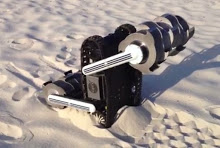The newest space explorer of the National Aeronautics and Space Administration (NASA), RASSOR is a mining robot at the prototype stage for now, but landing a similar robot to moon is planned. It is both an autonomous and a teleoperated mobile robotic platform with space excavation abilities and can be regarded as a closer step to have a lunar base that is sustainable.
RASSOR is the acronym of Regolith Advanced Surface Systems Operations Robot and pronounced as “razer”. The applications of RASSOR are described by NASA as follows: Extraterrestrial in situ resource utilization (ISRU), construction operations in space, space mining of soil and water ice, robotic mining operations and autonomous and teleoperated sand mining. The benefits of RASSOR are: weight/space efficiency, low gravity capability, versatility, reliability, maintainability and its scale.
Its design may look bigger in comparison to the rovers in the past. The challenge of an excavator robot for space is its size and weight: it has to be light and small enough to blast off but heavy enough to work in low gravity at the same time. Nevertheless, with almost zero reaction force, RASSOR can freight, carry and dump space regolith safely even in extremely low gravity. At each end of the robot, there are digging bucket drums which rotate in opposite ways and enable enough traction on one end to dig the soil by the opposite side. It is also designed considering the 1/6th gravity field of the moon. RASSOR’s height is 2.5 feet (76 centimeters) and it has 100 pounds weight (a bit more than 45 kg). For a concept mission it would have a 2000 pound cargo apart from the lander, thus the remaining payload can be used in order to process the lunar soil delivered. This light robot lowers the costs of space transportation: instead of approximately $4,000 per pound for hovering, RASSOR would have the minimum cost with high efficiency on precursor landing missions. Furthermore, like bulldozers, there are also shallow scoops shaving the soil instead of scooping large chunks all at once. It can be resembled to a small tank chassis. Thanks to drums mounted on moving arms, the robot can step and climb over obstacles by acting as legs and can easily take the position of Z shape to drop the gathered soil into the hopper. When the drums are above the main body, the robot has 2 ½ feet tall.

The task of RASSOR is gathering resources by collecting the lunar soil and drain it through another machine back to moon’s surface. The other machine set apart water and ice from debris and turns it into breathable air for astronauts working on the surface or fuel. Since generally a rocket’s considerable volume (approximately 90 percent) is fuel, providing fuel on the spot would enable NASA to dispatch more loading to the mission. It would be also possible for the missions on Mars, on an asteroid or a comet. It is not such an easy task for RASSOR due to the fact that in order to obtain 40 pounds of soil, the robot must accelerate up to 20 centimeters per second and moreover gathering enough soil for the mission would take 16 hours a day for five years.
NASA aimed at developing a robot that can work throughout the day and every day for years: That is why the “blue collar robot” simile is appropriate. In addition to its other benefits, the platform design can be scaled up or down according to the needs of the project. Larger versions of RASSOR could be used in mining operations which are on earth and difficult to achieve, challenging or dangerous. There are wireless control, telemetry and onboard transmitting cameras that allow teleoperation. In addition to that the robot can be programmed according to the selected task and it can operate autonomously.
RASSOR is tried out at NASA’s Kennedy Space Center in Florida. Although the current prototype has rubber material in tracks, in lunar version would probably have a different material such as a metal. For the second generation of RASSOR prototype, tracks that of tanks or wheels are being considered by the researchers because of the fact that in recent tests, pebbles and sand clogged the gear. RASSOR will not have a mission soon but RASSOR 2 is being designed and it probably will be on trial after 2014.

You must be logged in to post a comment Login